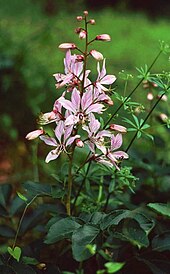Am Wolfsberg nature reserve
|
At Wolfsberg
IUCN category none - not specified |
||
|
View from the Zigeunerfelsen to Wolfsburg |
||
| location | Rhineland-Palatinate , Germany | |
| surface | 3 ha | |
| WDPA ID | 81298 | |
| Geographical location | 49 ° 22 ' N , 8 ° 6' E | |
|
|
||
| Setup date | 1984 | |
The nature reserve Am Wolfsberg near Neustadt an der Weinstrasse is a three hectare nature reserve in Rhineland-Palatinate .
Geographical location
The nature reserve is situated on a southwest exposed hillside above the Speyerbach valley with the suburb of Neustadt-Schoental on the western edge of the mountain Neustadter of the Palatinate Forest herein as, Haardt is called.
history
Wolfsburg , which was first mentioned in a document in 1255, was built over a bend in the Speyerbach valley . It was ruined in the Thirty Years War . In 1847 the railway tunnel was built through the Wolfsberg .
In 1925 an application was made to place the area on Wolfsberg under nature protection. The corresponding ordinance was only announced in December 1953, the current ordinance dates from 1984.
geology
A Zechstein limestone bank is located on the Rotliegend of the Speyerbach valley at the height of the Wolfsberg tunnel. Above this lie the layers of the lower red sandstone , the Eck conglomerate and the middle red sandstone.
Terrain and soil
The Wolfsberg has steep slopes and small rock faces from former quarries. The terrain is characterized by shallow sandy soils.
climate
The nature reserve is influenced by the oceanic, humid climate of the Palatinate Forest and the mild, dry climate of the Rhine plain.
Flora and vegetation
Several floristic studies and a vegetation study have been carried out in the area. Over 270 vascular plant species have been identified, including numerous heat- and light-loving representatives; in addition, sub-Mediterranean and foreign species were found. Endangered species on the Red List and protected species also occur. In addition to anthropogenically influenced plant communities, typical forest communities on the slopes and an interesting penetration of fragments of two vegetation communities on the Red List, the Genistello-Phleetum phleoidis and the Geranio-Trifolietum alpestris (“steppe heather”, i.e. dry grass, warmth-loving perennial fringes, bushes or dry forests, were found develop on rocky soil with a thin layer of fine earth).
See also
Web links
Individual evidence
- ↑ Map of the nature reserve, LANIS, landscape information system of the Rhineland-Palatinate nature conservation administration map1.naturschutz.rlp.de
- ^ Ordinance on the nature reserve "Am Wolfsberg" of January 19, 1984.
- ↑ Climate of Neustadt an der Weinstrasse climate diagram-Neustadt ad- Weinstrasse-Deutschland-metrisch-deutsch.png
- ↑ Vegetation Science and Plant Sociology Vegetation Science
- ^ Arno Stumpf: Investigations into the nature reserve Wolfsberg near Neustadt / Weinstrasse . Housework, Landau University of Education, 1972
- ^ Margit Sternad: Flora and vegetation of the nature reserve Am Wolfsberg near Neustadt an der Weinstrasse . Admission thesis, Heidelberg University of Education, 1982
- ↑ Red lists in floraweb.de
- ↑ Dictamnus albus , White Diptam floraweb.de
- ↑ Muscari comosum , Schopfige Grubenhyazinthe floraweb.de
- ↑ Trifolium rubens , Purpur-Klee floraweb.de
- ↑ Iris germanica , German Iris floraweb.de
- ↑ Primula veris , meadow cowslip floraweb.de
- ↑ Anthericum liliago , Traubige Graslilie floraweb.de
- ↑ Red list of plant communities in floraweb.de
- ↑ Genistello-Phleetum phleoidis, winged gorse- glossy shrub grass floraweb.de
- ↑ Geranio-Trifolietum alpestris, Blutstorchschnabel-Waldklee -Saum floraweb.de
- ↑ Steppe heath and former steppe heath theory




